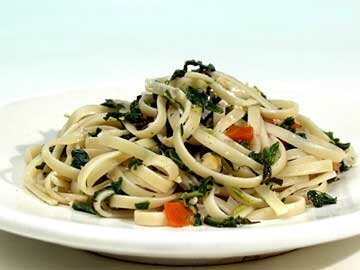healthy food tip and recipe
Today's Recipe
If you don't know what to serve for dinner tonight ...
With so many people in love with pasta we decided to create one that is not only rich in nutrients but is easy to prepare. Frozen spinach saves you lots of time and still provides you with good nutritional value. If you have time, you can use fresh spinach for optimum flavor and nutrition.

Ingredients:
- 1/2 lb whole wheat fettuccini
- 1 10oz package of frozen spinach, (make sure frozen spinach is chopped, otherwise it gets stringy).
- 3 medium cloves garlic, coarsely chopped
- 2 TBS coarsely chopped walnuts
- 1/2 cup chopped fresh basil
- *optional 2 oz Chevre' goat cheese
- 1 TBS lemon juice
- 1/4 cup water
- 2 TBS extra virgin olive oil
- 1 large tomato, seeds and excess pulp removed, diced
- salt and pepper to taste
- Bring lightly salted water to a rapid boil. Cook fettuccini according to directions on package.
- While fettuccini is cooking rinse frozen spinach in warm water to thaw, and press dry. Put into food processor along with garlic, walnuts and basil. Run food processor a couple of minutes before adding liquids. Add cheese, lemon juice, water, olive oil and salt and pepper. Process just enough to blend all ingredients well.
- Prepare tomato by cutting in half, squeezing the seeds out, removing excess pulp in the center, and dice.
- As soon as you drain pasta mix in desired amount of pesto, and chopped tomato while it is still very hot. Serve immediately.
- Garlic Shrimp Salad
In-Depth Nutritional Profile for Fettuccini with Spinach Pesto
Healthy Food Tip
I was wondering why bread doesn't appear anywhere in your website.
You've asked an excellent question, and you've also made a very astute observation about our website. We don't include bread in any of our website recipes, and we don't discuss bread making on our website, even though bread is a staple food in the United States and in many other countries as well.
Since most bread is made from grains, the section of our website that comes closest to profiling "bread" is our Grains section. Any of the 10 grains we profile in this section could be used to make bread. If the bread was 100% whole grain, you could treat the nutritional information in this section of the website as basically synonymous with the nutritional information related to bread. For example, in our wheat profile, we provide the nutritional profile for a cup of cooked bulgur wheat containing about 150 calories. That profile would be similar to (although not identical with) the profile for a 100% whole wheat bread containing the same amount of calories.
In general, we have not emphasized consumption of grains in our Healthiest Way of Eating. When we do include grains in our eating plans, they tend to be included in pure form (just the whole cooked grains themselves) rather than forms in which they have been ground into flour and baked into bread. We are by no means opposed to 100% whole grain breads, and believe they can play a very beneficial role in many meal plans. However, the general approach we take on our website is much more of a "Paleolithic Diet" approach in which the main staples in the meal plan include many naturally-occurring fruits and vegetables, as well as nuts, seeds, legumes, and fish, as opposed to a grain-based meal plan that would focus on these cultivated crops that occurred much later in the history of cuisine.
We would strongly recommend avoidance of the "high-extraction" breads, however. "High-extraction" means that a large percent of the whole grain (usually about 40%) gets extracted prior to the making of the flour. When 40% of the whole grain gets extracted out at the beginning of a bread making process, the bran and the germ portions of the grain are the first to go. These portions contain virtually all of the fiber, most of the minerals, and the majority of the vitamins. From a nutritional standpoint, the result is bread that bears little resemblance to the grain from which it was made. Most of the breads in an U.S. supermarket are made from 60% extraction wheat flour, and they typically contain less than 1 gram of fiber. We also recommend checking the nutrition panel on your bread bag. You might find "Whole Wheat Bread" in huge letters on the front of the bag, when the bread actually contains less than 1% whole wheat. The catch here is the percentage. The breads you can t rust to contain whole wheat are the breads marked "100% Whole Wheat Bread" on the front of the bag. Any 100% whole grain bread-whether it be wheat or another type-are going to be your best bets in this food category.
For more information on this topic, see:



No comments:
Post a Comment